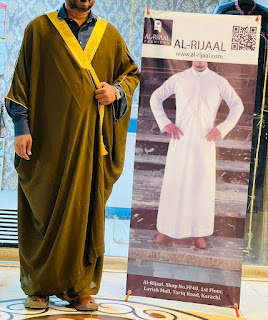The Arabic Traditional Bisht / Mishlah: A Symbol of Prestige and Heritage
The Bisht, also known as Mishlah, is a traditional Arabic cloak that has been a symbol of prestige, heritage, and nobility for centuries. Worn primarily by men, the Bisht is often associated with royalty, scholars, and individuals of high social standing in Arab culture. This elegant outer garment, typically made from fine wool and adorned with intricate gold or silver embroidery, is commonly seen at weddings, religious ceremonies, and significant state functions.
History and Origin of the Bisht
The Bisht has its roots in ancient Arabia, where it was initially worn as a practical garment to protect against the desert’s harsh climate. Over time, it evolved into a sign of status and honor, worn by leaders, scholars, and esteemed individuals. The tradition of wearing a Bisht can be traced back to pre-Islamic times, and it continues to hold a prestigious place in Arab culture today.
Design and Craftsmanship
A Bisht is made from high-quality wool or camel hair and comes in various shades, including black, brown, beige, and gray. The most striking feature of the Bisht is its intricate gold or silver embroidery along the edges, particularly around the collar and front opening. The embroidery is often hand-stitched, showcasing exceptional craftsmanship that has been passed down through generations.
Bishts are available in different weights and textures, making them suitable for various occasions and seasons. Lighter versions are worn during summer, while heavier ones provide warmth in the colder months. The quality and embellishments of the Bisht determine its price, with some high-end designs costing thousands of dollars.
Significance and Occasions
The Bisht is more than just a traditional garment; it represents dignity and respect. It is worn on special occasions such as:
- Weddings: The groom often wears a Bisht over his thobe to signify importance and elegance.
- Religious Gatherings: Clerics and scholars wear it during religious sermons and prayers.
- Graduations: University graduates don a Bisht as a symbol of achievement and respect.
- State Functions: Kings, princes, and dignitaries wear Bishts at official ceremonies and diplomatic events.
- Eid Celebrations: Many men wear the Bisht during Eid to mark the occasion with elegance and tradition.
Modern-Day Influence
Despite modern fashion trends, the Bisht remains a cherished part of Arab attire. Contemporary designs integrate subtle modifications to suit modern preferences while maintaining the garment’s traditional essence. Luxury brands and high-end designers now offer custom-made Bishts, further elevating their status as a symbol of sophistication.
Conclusion
The Bisht / Mishlah is more than just a piece of clothing—it is a cultural icon that embodies history, tradition, and prestige. Whether worn by a groom on his wedding day or by a leader at a state event, the Bisht continues to be a revered garment in the Arab world. Its timeless elegance and deep-rooted significance ensure that this traditional attire remains a treasured part of Middle Eastern heritage for generations to come.


.jpeg)


0 Comments